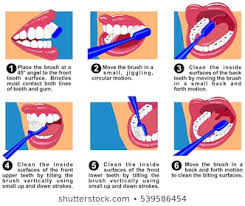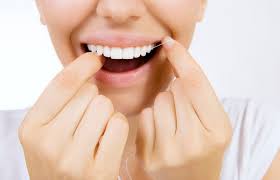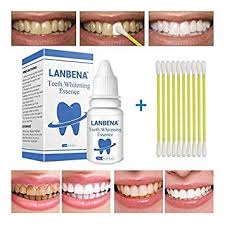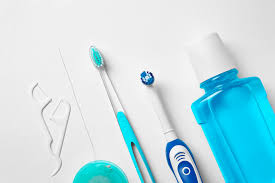What is Oral Hygiene?
Wikipedia, the free encyclopedia says, Oral hygiene is the practice of keeping one’s mouth clean and free of disease and other problems (e.g. bad breath) by regular brushing of the teeth (dental hygiene) and cleaning between the teeth. It is important that oral hygiene be carried out on a regular basis to enable prevention of dental disease and bad breath.
The most common types of dental disease are tooth decay (cavities, dental caries) and gum diseases, including gingivitis, and periodontitis.
Recommended Cleaning Of Teeth
 General guidelines suggest brushing twice a day: after breakfast and before going to bed, but ideally the mouth would be cleaned after every meal.
General guidelines suggest brushing twice a day: after breakfast and before going to bed, but ideally the mouth would be cleaned after every meal.
Routine tooth brushing is the principal method of preventing many oral diseases, and perhaps the most important activity an individual can practice to reduce plaque buildup. Controlling plaque reduces the risk of the individual suffering from plaque-associated diseases such as gingivitis, periodontitis, and caries – the three most common oral diseases.
The average brushing time for individuals is between 30 seconds and just over 60 seconds. Many oral health care professionals agree that tooth brushing should be done for a minimum of two minutes, and be practiced at least twice a day. Brushing for at least two minutes per session is optimal for preventing the most common oral diseases, and removes considerably more plaque than brushing for only 45 seconds.
Tooth-brushing can only clean to a depth of about 1.5 mm inside the gingival pockets, but a sustained regime of plaque removal above the gum line can affect the ecology of the microbes below the gums and may reduce the number of pathogens in pockets up to 5 mm in depth.
Toothpaste (dentifrice) with fluoride is an important tool to readily use when tooth brushing. The fluoride in the dentifrice is an important protective factor against caries, and an important supplement needed to remineralize already affected enamel.
However, in terms of preventing gum disease, the use of toothpaste does not increase the effectiveness of the activity with respect to the amount of plaque removed.
Flossing Teeth
 Cleaning between the teeth is called inter-dental cleaning and is as important as tooth brushing. This is because a toothbrush cannot reach between the teeth and therefore only removes about 50% of plaque from the surface of the teeth. There are many tools to clean between the teeth, including floss and inter-dental brushes; it is up to each individual to choose which tool they prefer to use.
Cleaning between the teeth is called inter-dental cleaning and is as important as tooth brushing. This is because a toothbrush cannot reach between the teeth and therefore only removes about 50% of plaque from the surface of the teeth. There are many tools to clean between the teeth, including floss and inter-dental brushes; it is up to each individual to choose which tool they prefer to use.
Since tooth brushing alone will not remove plaque from all surfaces of the tooth as 40% of the surfaces are inter-dental. One technique that can be used to access these areas is dental floss. When the proper technique is used, flossing can remove plaque and food particles from between the teeth and below the gums. The American Dental Association (ADA) reports that up to 80% of plaque may be removed by this method. The ADA recommends cleaning between the teeth as part of one’s daily oral hygiene regime.
Whitening Teeth
 Sometimes white or straight teeth are associated with oral hygiene. However, a hygienic mouth can have stained teeth or crooked teeth. To improve the appearance of their teeth, people may use tooth whitening treatments and orthodontics.
Sometimes white or straight teeth are associated with oral hygiene. However, a hygienic mouth can have stained teeth or crooked teeth. To improve the appearance of their teeth, people may use tooth whitening treatments and orthodontics.
Please Leave All Comments in the Comment Box Below ↓
- Dental Floss
- Mouthwash
- Toothpaste
- Teeth Whitening
















Hello and thanks for reminding about oral care and hygiene. I used to brush my teeth before breakfast when I was kid. Glad I changed that habit to after breakfast. Oh, I brush my teeth in one minute, so I guess I need to spend more time cleaning my teeth. Is flossing required to maintain our oral health? And if so, when do you suggest to do it? After brushing? Thanks for your recommendation
Thank you for reading and commenting on this article. You are most certainly welcome for the reminder about oral care and hygiene. Although I did not make a request to answer questions, if you thoroughly read this article, the answers to your questions are explained in detail.
Thank you again for your comment.
Have A Blessed Day!
I perfectly agree with you about brushing the teeth after having a meal. For the food particles may easily cause mouth odor. Your write up is on point and I also learned about one important thing you mentioned. using tooth paste that contain Flouride and i also learned about floss.
These are all new words to me and I am happy I came across this article. Keep the good work and keep writing from the heart. I would like to share this vital information on my social media platforms for others to learn from this master piece..
I would have loved to know if you have any recommendations of toothpaste containing Flouride?
Thank you for reading and commenting on this post.
I am extremely thankful that you have learned some things from this post. This motivates me to keep creating posts of this nature.
To answer your question there are many choices of toothpaste containing Fluoride, such as: Crest Pro Health, Colgate, Total, Aim, the list continues on.
Thank you again for taking the time to read and comment on this post. I would also like you to share your article on your social media.
Best Of Blessings To You My Friend!